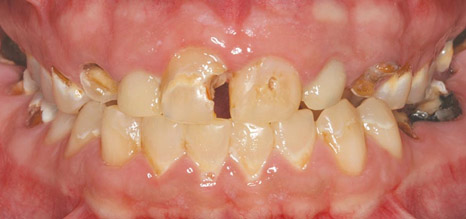Menu
Menu
My dentist diagnosed me with gum disease and said my smoking was a factor. Would it be healthier for me to switch to e-cigarettes?
Many people have turned to vaping because they think it is healthier than smoking. At first glance, e-cigarettes seem to have advantages over regular cigarettes: they are much less smelly and do not have the same chemical hazards as burning tobacco. However, e-cigarettes have their own problems. The more we learn about them, the more evidence we have that vaping can do just as much harm to your oral health as smoking.
Electronic cigarettes provide a heated mixture of water, flavouring, nicotine and other chemicals. What makes them potentially dangerous is that they produce an aerosol, not just a vapour as the term 'vaping' might indicate. While vapour is simply a gaseous form of a substance, an aerosol means that particles are suspended in the vapour. E-cigarette aerosols contain particles of various chemical compounds, many of which pose a risk to your oral health as well as your general health.
For example, regular cigarettes and electronic cigarettes are primarily delivery systems for nicotine, which has long been associated with gum disease and tooth loss. Nicotine constricts blood vessels, so there is less blood flow to the gums, it interferes with immune function and it damages the connective tissues that hold teeth in place. This leads to a much higher risk of gum disease and eventual tooth loss.

Here is a patient who stopped smoking regular cigarettes and then vaped for four years. Because his mouth was so dry after using electronic cigarettes, he regularly consumed sports drinks, most of which are highly acidic and contribute to tooth erosion. Although he is still a young man, the combination of vaping and exposure to sports drinks has damaged his teeth.
Although early generations of electronic cigarettes delivered less nicotine than regular cigarettes, today's electronic cigarettes deliver nicotine more efficiently. The nicotine in e-cigarette aerosols is absorbed primarily through the mucous membranes of the mouth rather than through the lungs, as with smoking, which could damage the oral cavity. In addition, one vaping cartridge can equal the nicotine dose of 20 cigarettes.
Vaping has become considerably more popular over the last five years, especially among young people. Sweet flavours such as cotton candy and chocolate chip biscuits are very attractive, as are "cooler" flavours such as mint and menthol. These flavours can cause many oral health problems associated with vaping.
Although many of the flavourings used in e-liquids have been approved for food use, they are not tested for safety when inhaled instead of swallowed. It is now known that some flavouring additives alter the chemistry of e-liquids by reacting to form new compounds that could irritate the oral mucosa and trigger an inflammatory response.
A study comparing the effects of flavoured versus unflavoured e-cigarette liquid on dental health found a 27% decrease in enamel hardness when flavoured electronic cigarettes were used. Compromised tooth enamel sets the stage for serious tooth decay, especially as the thick e-liquid allows cavity-causing bacteria to adhere to the surface of the teeth. A different experiment found that e-cigarette flavours increased cell damage and cell death, with menthol flavour causing the most damage.
A main ingredient in electronic cigarettes is propylene glycol, a thick, slightly sweet liquid that can damage tooth enamel and soft tissue in the mouth. Another major component of e-liquids is vegetable glycerin, used in the food industry to add sweetness and retain moisture. When combined with flavouring compounds, vegetable glycerin causes a fourfold increase in bacterial adherence to tooth enamel and a twofold increase in the formation of plaque biofilm, the main culprit in gum disease and tooth decay.
Other chemicals found in e-cigarette liquids or aerosols include formaldehyde, lead and several other toxins and carcinogens. Exposure to some of these chemicals can increase the risk of oral cancer.
One of the most common side effects reported by e-cigarette users is dryness and irritation of the mouth and throat. Dry mouth, especially in conjunction with the sugar levels in e-liquids, can lead to oral health problems. When your mouth does not have enough saliva, harmful bacteria can thrive, making it more likely that tooth decay and gum disease will develop and progress.
Many people believe that vaping is a healthy alternative to smoking, and that is how it has been marketed to the public. But current research and clinical experience paint a very different picture. We now understand that when exposed to e-cigarette aerosols, teeth begin to break down as bacteria in the mouth digest the sugar in the e-liquid and begin to produce acid. This is particularly true in the areas most exposed to e-liquid, i.e. the front teeth and interdental surfaces.
There is still much to learn about the long-term effects of e-cigarette use on oral and overall health. But from what we know so far, vaping can be just as dangerous to oral health as smoking, and perhaps even more so. It cannot be considered a healthier alternative to smoking, especially if you have gum disease. However, many people have successfully quit smoking, often with the help of online programmes, local or online support groups, over-the-counter or prescription medicines or other smoking cessation aids. Quitting smoking in any form is one of the best things you can do for your gums and overall health.
